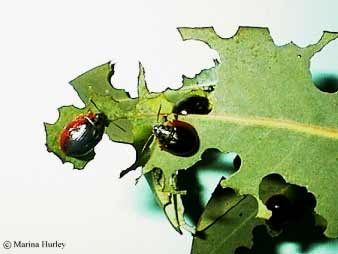|
Managing insect pests

Silvicultural methods
Ideally, choosing tree species that are suited to the local
environment is best, as the local ecology will help reduce
any insect pest outbreaks. Vigorous, healthy plants will either
be less likely to sustain an attack or if so, will deal with
it better than stressed, poorly-growing trees. Regular thinning
and pruning may reduce attack in some circumstances, especially
if trees are attacked by caterpillars, making it more difficult
for infestations to spread from tree to tree. Debarking trees
immediately after felling may reduce attacks of wood-boring
beetles.
Natural enemies
Often the natural enemies of insects will effectively control
small, periodic outbreaks including predators, parasitoids
and pathogens. Ensuring that the understorey is diverse as
possible will help encourage populations of natural enemies.
Chemical control methods
Repeated chemical spraying is expensive, unhealthy to humans,
animals and the environment in general, and can cause some
pests to increase in abundance by killing natural predators,
such as other insects, spiders and lizards. Broad action insecticides
that are sprayed repeatedly create a situation in which there
is intense selection pressure for resistant individuals. Those
insects that survive from regular and intense spraying will
produce offspring that will also survive. These individuals
can then proliferate in an insecticide treated area. Judicious
use of chemical insecticides, combined with cultural methods
that encourage natural control will offset the expansion of
resistant insect pests
The decision process involved when undertaking insect control
is not straightforward and can require detailed knowledge
of the insects’ biology. Correctly identifying the pest
is very important. Similar-looking pests may require different
control methods. Some insects are nocturnal or live in the
soil and are not necessarily present when damage inspection
is taking place. Similar damage to leaves and seedlings can
be caused by both insects and mammals, and birds may be responsible
for pulling up seedlings by their roots. Knowing when to apply
chemical or microbial insecticide is important, as applications
need to be carried out before the population has reached damaging
proportions.
Planting trees
to reduce the impact of pests
Back to top
|
